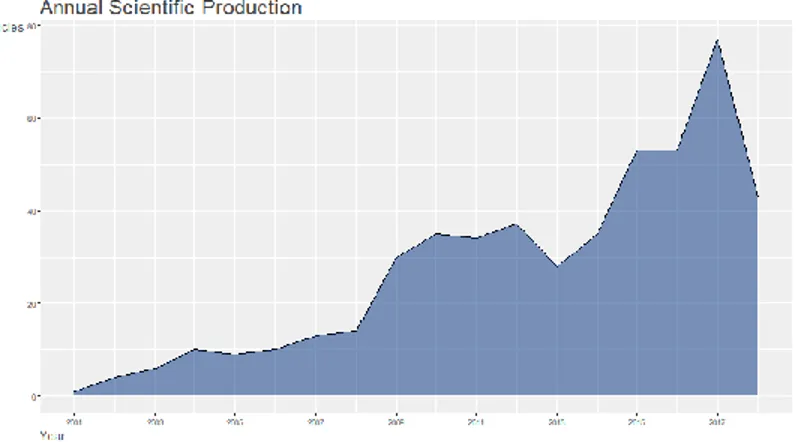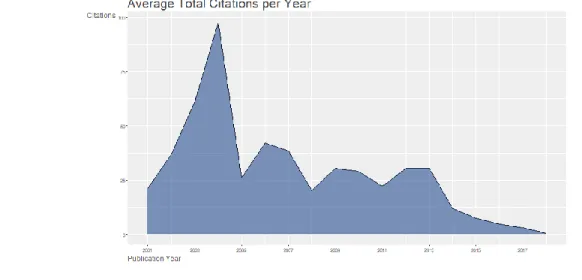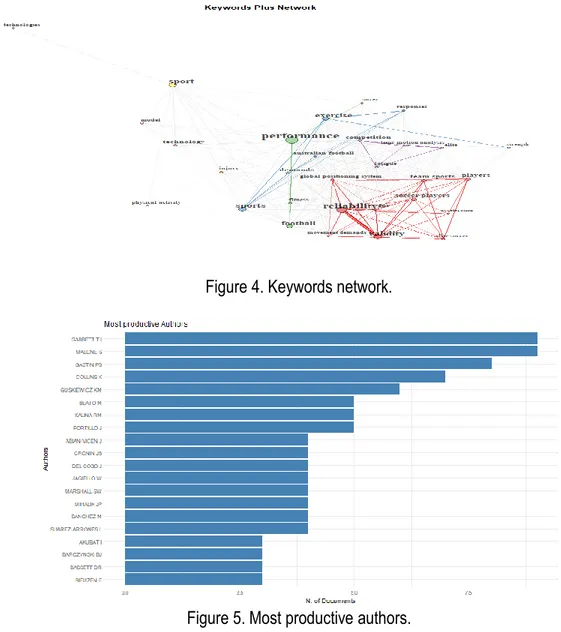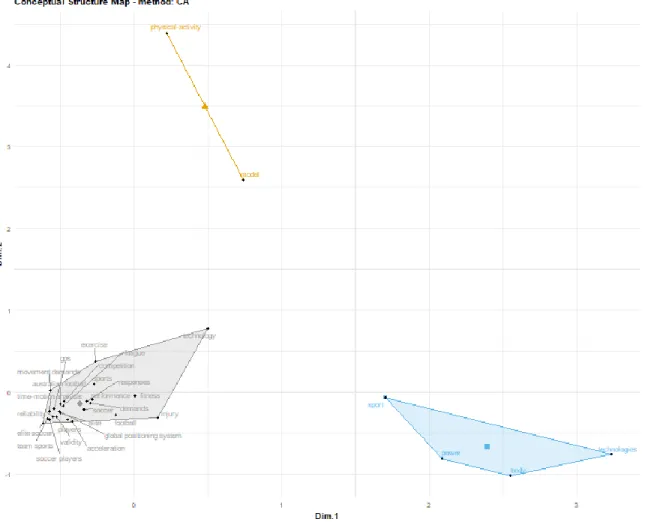932 | 2020 | ISSUE 4 | VOLUME 15 © 2020 University of Alicante
Technology and sport for health promotion: A
bibliometric analysis
PATRIZIA BELFIORE 1 , ANTONIO ASCIONE, DAVIDE DI PALMA
Department of Sport Sciences and Wellness, Parthenope University, Naples, Italy
ABSTRACT
The world of sport is continually changing and the use of technology is one of those areas that has made an impact on many sports and on health promotion. The aim of this work is to establish, through a bibliometric analysis, whether and how technology can change the way of doing sport, favouring health promotion. The study develops a bibliometric overview of all the journals that are currently indexed in Web of Science (WoS) database in any of the categories connected health-technology-sport research. The research has studied the influential concepts and themes in the field of health promotion through technological innovations in sport. The analysis was conducted using the frequency of keywords and citations from the articles published between 2000 and 2018. The work identifies the leading journals in health research through a bibliometric approach. The analysis shows a deep overview of the results of health journals. It is worth noting that many journals have entered the WoS database during the last years, in many cases to fill some specific niche that has emerged in the literature, although the most popular ones have been in the database for a long time.
Keywords: Sport; Technology; Health promotion; Bibliometrics.
1Corresponding author. Department of Movement and Wellbeing Sciences, University of Naples Parthenope, via Medina 40,
80133 Naples, Italy.
E-mail: [email protected] Submitted for publication February 2019 Accepted for publication March 2019
Published December 2020 (in press December 2019)
JOURNAL OF HUMAN SPORT & EXERCISE ISSN 1988-5202 © Faculty of Education. University of Alicante
doi:10.14198/jhse.2020.154.19 Cite this article as:
Belfiore, P., Ascione, A., & Di Palma, D. (2020). Technology and sport for health promotion: A bibliometric analysis. Journal of Human Sport and Exercise, 15(4), 932-942. doi:https://doi.org/10.14198/jhse.2020.154.19
VOLUME 15 | ISSUE 4 | 2020 | 933
INTRODUCTION
Technological developments provide new solutions for guiding patients to a physically active lifestyle. The world of sport is continually changing over the years, and the use of technology is just one of those areas that has made an impact on many sports in the modern day (Backer, 2015, Freeman, 1991; Burkett, 2010). One criticism of the use of technology is that it can slow down the speed of the game, but on the other hand for many people it makes watching it more enjoyable to see the correct decisions being made.
Innovation is a driver of growth and well-being and health promotion. New technologies, products, services and organizations create jobs and rejuvenate industries. But to reap those gains, policy makers need to understand how the way we innovate is changing. This has implications for human resources and education systems if they are to feed this innovation society. This also presents new opportunities for innovation and improvement in sport systems (Collins, 2011; Edwards, 2008).
The concept of technology is ambiguous and has been analysed from various prospective. Dictionary definition see “technology” as “… material object of use to humanity such as machines, hardware or interests”. The authors polarize and specify this common sense understanding when they talk of “… materials devices designed and manufactured to make possible activities which people have dream of engaging in but to which they are not biologically adapted”.
In this line, we shall understand technology as human-made means to reach human interests and goals. Sport technology, then, are human mode means to reach human interests and goals related to sport (Marcellini, 2012; Magdalinski, 2000, Foster, 2012, Belfiore, 2018).
Whilst in many sports it has been proposed that performance is starting to indicate a reducing or plateaued nature in their rate of improvement, it has been claimed that any significant gains in the future will be as a result of technical innovation (Francis, 2005; Haake, 2009). For example, in speed skating, it has been claimed that half of the progress of world records to date have been as a result of changes in technology with the other half from real athletic improvement (Hemphill, 2009; Holowchak, 2002; Howe, 2011; Loland, 2008-2009). Additionally, if a change in sports technology is implemented, its impact in a sport can often be clearly identified (Liguori, 2017). The implementation of technology has a significant impact in cycling, the 100 m sprint, and the javelin as well as the pole vault, long jump, high jump, triple jump, amputee sprinting and swimming (Belfiore, 2018; Ascione, 2018). As a result, the innovation, design and application of technology to competitive sport is of paramount importance to athletes looking to optimize their best possible performance in the future. Occasionally though, the introduction of new technology can cause debate or controversy (Yao, 2014; Paganini, 2006; Wolbring, 2013). A summary of the philosophical and hypothetical factors regarding the impact or introduction of a product or technology to a sport was summarized by Dyer (Dyer, 2011). These criteria is typically relative in nature meaning that the best ethical outcome cannot always be clearly or robustly defined. The field of study that surrounds the decision making or debate with respect to the actual acceptability, inclusion, or controversy of sport technology has been termed performance enhancement (Zettler, 2009), techno sport human enhancement technologies or mechanical ergogenic (Kokko, 2006; Crisp, 2003; Di Palma, 2018). In addition, if technology has been employed with questions of unfairness or negativity surrounding its use, this has also been termed technological doping (Aggestal, 2015) or techno doping (Lawson, 2005).
934 | 2020 | ISSUE 4 | VOLUME 15 © 2020 University of Alicante Objective
The aim of this work is to establish, through a bibliometric analysis, whether and how technology can change the way of doing sport, favouring health promotion.
METHODS
In this study, bibliometric methodology was applied using Web of Science (WOS). WOS is 100% inclusive of Medline and is considered one of the largest databases. Therefore, WOS is considered very suitable for bibliometric analysis based on the advantages it has over other databases. Furthermore, the search engine of WOS gives a wide range of search scenarios that can allow maximum retrieval of related documents. The output obtained from Scopus can be easily exported and analysed foremost active authors, institutions, countries, journals, subject areas, citations, and keyword mapping. The keywords used in this study were technology, sport and health. Retrieved literature was analysed by exporting the data from WOS to Excel software for calculation and tabulation. The exported data included the following information: number of published documents in each year, types of published documents, subject areas, names of journals, names of authors, country and institutional affiliation of authors who participated in publishing the retrieved literature. For citation analysis, Scopus provides the number of citations received for each article and allows the sorting of articles based on the number of citations. Furthermore, the Hirsh (h-index) of any group of retrieved documents can be provided by WOS for comparative purposes. The h-index is an author-level metric that attempts to measure both the research productivity and citation impact of the publications of a scientist or a country or an institution. WOS also allows the export of all retrieved data to excel for purposes pertaining to geographical mapping or visualization of author keywords or author networking or country collaboration. Growth of publications and statistical analysis were carried out using the Bibliometrix Package. The bibliometrix R package (www.bibnliometrix.org) provides a set of tools for quantitative research in bibliometrics and scientometrics (Aria, 2017).
RESULTS
Growth of publications
In total, 782 documents discussing the sport, technology and health were retrieved. The highest number of documents was published in 2017 with a total of (150; 19%) documents. More than half (466;59,6 %) of the retrieved documents were published in the last five years of the study period (2013–2017). Figure 1 shows the Annual Scientific Production.
VOLUME 15 | ISSUE 4 | 2020 | 935
Types of documents and subject areas
The majority of the retrieved documents were research articles (586; 74%) followed by review articles (195; 25%) and proceedings paper (9; 1%). The language of the retrieved articles was only English (782; 100%). The majority of documents were published in journals within the subject area of sport science (646;83 %), followed by those in management (146; 19%), educational research (94; 12%), and physiology (46; 6%). Overlap in various subject areas created a total percentage of more than 100% (Figure 2).
Figure 2. Articles for scientific area.
Citation analysis
Retrieved documents received 8,641 citations, an average of 11,05 citations per document. The h-index of the retrieved documents was 43. The highest number of citations attained was 385 for a study “American Medical Society for Sports Medicine position statement: concussion in sport” by Harmon, Kimberly G et al. The average total citations per year are shown in Figure 3. Notably, the majority of highly cited articles were published sport science and sport health journals. All highly cited articles were research articles and none were review articles. Most of the highly cited articles were published during the second decade of the study period (2008 - 2017).
936 | 2020 | ISSUE 4 | VOLUME 15 © 2020 University of Alicante Keywords plus network
Most frequent author keywords analysis of occurrences of author keywords using a minimum of 10 occurrences retrieved 42 keywords distributed within different clusters. The most frequently encountered keyword was the one with the largest node size shown in the map as “performance” and reliability (Figure 3). The map also included (1) technology; (2) team sport; (3) competition (4) physical. The key-words related to health promotion have a smaller node size than that for “sport ”.
The network tend to be centralized with a couple of central concepts including performance, sport, health promotion, and technology (Figure 4). It was interesting that performance has the largest node despite the fact that model had the largest frequency. In other words, even though model was the most frequently occurring keyword, performance was co-occurred more with other keywords in the network. The pair of sport and technology had the shortest distance. Moreover, the triangular relationships among performance, technology and sport implied that these three concepts were closely intertwined in the articles. Although the visualized networks enable us to see the structures of relationships intuitively, it is hard to uncover the unique features or patterns if the network has a large number of nodes and links.
Figure 4. Keywords network.
VOLUME 15 | ISSUE 4 | 2020 | 937
Most productive Countries
Authorship analysis in total, 835 authors participated in publishing the retrieved documents giving a mean of 2.4 authors per article. The most active authors are listed in Figure 5. Dottor Tim J Gabbett (School of Exercise Science, Australian Catholic University) was the most prolific author in this topic. Other productive authors on that subject were Malone S, Gastin PB and Collins K (Harmon, 2013, Gabett, 2017; Malone, 2017). About the most active countries, the USA was the most productive in this field with 348 (44.5%) documents followed by the Europe (276; 35%). Figure 6 shows most active countries along with the citation per article for documents published by each country. International collaboration among the most active countries indicated that California has the highest percentage (56.2%) of documents with international authors (MCP) while Australia had the lowest percentage (19.2%). The geographical distribution of publications based on the country affiliation of authors indicated that most publications about sport, technology and health promotion were coming from North America, Australia, and Western Europe.
Figure 6. Country scientific production.
Preferred journals
The retrieved documents were published in 658 different peer-reviewed journals. The top 10 preferred journals for publishing in this field was Journal of Science and Medicine in Sport followed by Journal of Human Sport and Exercise, Sport Management Education Journal and Sports Medicine. The list included different journals in the field of sport/technology while the remaining journals were in the field of public health and general medicine.
Structure map
The function conceptual Structure creates a conceptual structure map of a scientific field performing Correspondence Analysis (CA), Multiple Correspondence Analysis (MCA) or Metric Multidimensional Scaling (MDS) and Clustering of a bipartite network of terms extracted from keyword, title or abstract fields. This method allows to derive a set of coordinate values summarizing the link between sport, technology and health promotion. The percentage of the variance of the principal components constructed using this method are known to under evaluate the information summarized. The interpretable principal components were kept. Each principal component has been interpreted by examining the contribution of each category, when it was significant, to the variance of the category coordinates.
938 | 2020 | ISSUE 4 | VOLUME 15 © 2020 University of Alicante
Graphical displays are used to summarize the proximities between the subjects and to show the associations between the categorical variables (Figure 7). The subjects are represented in two-dimensional graphical displays constructed using principal components as axes system. The purpose of this study was to identify the link between new technology and sport for health promotion.
Figure 7. Map model.
The aim of the data analysis is first to characterize by bibliometrix of new technology for the sport and sport and lifestyle. Consequently, these latter variables are considered as supplementary variables. It means that they are not used to build the scores, but only projected afterward onto the graphical representations that have been obtained. They are used to enhance the interpretation
DISCUSSION
In this study we wanted to shed some light on the research activity on the relationship between sport, technology and health. The results of our study indicated that (A) research activity in this field showed a significant increase in recent years, most likely due to the use of new technologies; (B) The research activity on health promotion has dominated the literature of almost all the countries of America and Europe; (C) the research activity linked to sport as a means/way of fostering wellbeing is a dominant topic today.
VOLUME 15 | ISSUE 4 | 2020 | 939 In recent years, the evidence base for new behaviour change interventions in the field of health has grown (Gastin, 2013; Sparling, 2000). Several systematic reviews evaluated the effectiveness of these interventions; many studies have focused on the behaviour of users' health in relation to sports activity. as shown by the evidence of the literature today, sport is increasingly used to promote healthy lifestyles. This paper provides evidence to support the positive effects of new technologies in health promotion interventions in all categories of subjects: children, adolescents and adults. Since the offer of new technologies in the healthcare sector is often linked to the resolution of diseases, sometimes comparisons with comparable control groups are lacking (Heart, 2011; Gabarron, 2012; ). Therefore, further research is needed to establish the true independent effects of new technologies as a way to prevent the pathological event. Nevertheless, this bibliometric analysis has found that combining the use of technology in the sports sector promotes the promotion of health and therefore of well-being.
Although two-thirds of the studies demonstrated satisfactory methodological quality, several quality criteria still have room for improvement (Heart, 2013; Kidholm, 2012).
The present bibliometric analysis shows, among other things, that the sport-health bond has become very consolidated in recent years. it has been leveraged that sport must be innovative thanks to the use of new technologies. At the same time the concept of health promotion was strengthened. health, as the WHO recalls, must be maintained by referring to a correct lifestyle.
Another observation we can make is that the countries in which the technology-sport-health relationship is more widespread are the most advanced countries such as Europe and America.
CONCLUSIONS
In conclusion, with the bibliometric methodology, results and analyses are useful in all sectors of health and sports research at the global level. This study identifies emerging areas of health and sports research such as public health, health promotion through sports activity. From a general point of view, health research, combined with sports, is very broad and includes a wide range of topics. This article classifies the material according to some of the most active topics. However, it is worth noting that more specific topics could also be considered because each journal considers specific topics that are not dependent on the topics followed by other magazines. In addition, the judgment assigns each magazine to a category, but sometimes the newspaper can also be considered in another category.
On the basis of the analysis carried out, we can state that the concept of sport is taking on important dimensions and the advent of new technologies can only strengthen this link between sport and health, or better sport and public health.
ACKNOWLEDGMENTS
We would like to acknowledge the cooperation of the health and sport institutions in giving permissions to conduct the study.
FUNDING
940 | 2020 | ISSUE 4 | VOLUME 15 © 2020 University of Alicante AUTHORS’ CONTRIBUTIONS
PB and AA designed the study. PB and DD supplied the data. PB collected, entered and analysed the economic data. All authors discussed data analyses and interpreted the results. All authors wrote the first draft of the manuscript. All authors critically revised and approved the final manuscript.
COMPETING INTERESTS
The authors declare that they have no competing interests.
REFERENCES
Aggestål A and Fahlén J, (2015). Managing sport for public health: approaching contemporary problems with traditional solutions. Social inclusion, 3 (3), 108. https://doi.org/10.17645/si.v3i3.197
Aria M. and Cuccurullo C. (2017). Bibliometrix: An R-tool for comprehensive science mapping analysis, Journal of Informetrics, 11(4), pp 959-975. https://doi.org/10.1016/j.joi.2017.08.007
Ascione A, Belfiore P, Di Palma D. Sports Program To Promote The Wellbeing Of People With
Disabilities. Acta Medica Mediterranea 2018; 34: 1261.
https://doi.org/10.19193/0393-6384_2018_5_194
Baker D (2015) The second place problem: assistive technology in sports and (re) constructing normal. Sci Eng Ethics 1–18.
Belfiore P, Miele A, Gallé F e Liguori G. (2018). Adapted physical exercise and stroke: a systematic
review. J Sports Med Phys Fitness. Minerva Medica.
https://doi.org/10.23736/S0022-4707.17.07749-0
Belfiore P, Di Palma D, Ascione A. Adapted Physical Activity (Apa) For The Tutelage Of Patients With Type Ii Diabetes. Acta Medica Mediterranea 2018; 34: 1257. https://doi.org/10.19193/0393-6384_2018_5_193
Burkett B (2010) Technology in Paralympic sport: performance enhancement or essential for performance? Br J Sports Med 44:215–220. https://doi.org/10.1136/bjsm.2009.067249
Collins H, Evans R (2011) Sport-decision aids and the "CSI-effect": why cricket uses Hawk-Eye well and tennis uses it badly. Public Understan Sci 21:904–921. https://doi.org/10.1177/0963662511407991 Crisp BR, Swerissen H. Critical processes for creating healthpromoting sports environments in Australia.
Health Promotion International 2003;18(2):145–52. https://doi.org/10.1093/heapro/18.2.145
Di Palma D, Ascione A, Belfiore P. Experimental Approach Of Water Polo Training To Improve
Psycho-Physical. Acta Medica Mediterranea 2018; 34: 1253.
https://doi.org/10.19193/0393-6384_2018_5_192
Dyer B, Noroozi S, Sewell P, Redwood S (2011) The fair use of lower-limb running prostheses: a Delphi study. Adapt Phys Act Quart 28:16–26. https://doi.org/10.1123/apaq.28.1.16
Edwards S (2008) Should Oscar Pistorius be excluded for the 2008 Olympic Games? Sport Ethics and Philos 2:112–125. https://doi.org/10.1080/17511320802221802
Foster L, James D, Haake S (2012) Influence of full body swimsuits on competitive performance. Procedia Eng 34:712–717. https://doi.org/10.1016/j.proeng.2012.04.121
Francis L (2005) Competitive sports, disability, and problems of justice in sports. J Philos Sport 32:127– 132. https://doi.org/10.1080/00948705.2005.9714677
Freeman W (1991) Sport and technology: on the cutting edge. Presented at: Sport Philosophy Academy Session, San Francisco, USA.
VOLUME 15 | ISSUE 4 | 2020 | 941 Gabarrón E y Fernández, L. (2012). eSalud y vídeos online para la promoción de la salud. Gaceta
Sanitaria, 26 (3) 197-200. https://doi.org/10.1016/j.gaceta.2012.03.004
Gabbett TJ, Whiteley R. (2017). Two training-load paradoxes: can we work harder and smarter, can physical preparation and medical me teammates? Int J Sports Physiol Perform 2017; 12(Suppl. 2):S250–S254. https://doi.org/10.1123/ijspp.2016-0321
Gastin PBBennett GCook JLJ. (2013). Influence of age and fitness on match and training activity profiles in junior Australian football. Science and football VII : the proceedings of the Seventh World Congress on Science and Football. 423-430.
Haake S (2009) The impact of technology on sporting performance in Olympic sports. J Sports Sci
27:1421–1431. https://doi.org/10.1080/02640410903062019
Harmon Kimberly G et al. (2013). American Medical Society for Sports Medicine position statement: concussion in sport. Br J Sports Med. https://doi.org/10.1136/bjsports-2012-091941
Heart T. & Kalderon E. (2013). Older adults: Are they ready to adopt health related ICT? International Journal of Medical Informatics, 82(11), 209-231. https://doi.org/10.1016/j.ijmedinf.2011.03.002 Hemphill D (2009) Performance enhancement and drug control in sport: ethical considerations. Sport in
Society 12:313–326. https://doi.org/10.1080/17430430802673668
Holowchak M (2002) Ergogenic aids and the limits of human performance in sport: ethical issues, aesthetic considerations. J Philos Sport 29:75–86. https://doi.org/10.1080/00948705.2002.9714624 Howe D (2011) Cyborg and supercrip: the paralympics technology and the (dis)empowerment of disabled
athletes. Sociology 45:869–882. https://doi.org/10.1177/0038038511413421
Kidholm K, Ekeland A. G, Jensen LK., Rasmussen J., et al. (2012). A Model for Assessment of Telemedicine Applications: MAST. International journal of technology assessment in health care, 28(01), 44-51. https://doi.org/10.1017/S0266462311000638
Kokko S, Kannas L, Villberg J. The health promoting sports club in Finland—a challenge for the
settings-based approach. Health Promotion International 2006;21(3):219–29.
https://doi.org/10.1093/heapro/dal013
Lawson HA. (2005). Empowering people, facilitating community development, and contributing to sustainable development: The social work of sport, exercise, and physical education programs. Sport, education and society, 10 (1), 135–160. https://doi.org/10.1080/1357332052000308800 Liguori G, Belfiore P, D'Amora M, Liguori R e Plebani M. The Principles of Health Technology
Assessment in Laboratory Medicine. ClinChem Lab Med 2017 Jan 1;55(1):32-37. https://doi.org/10.1515/cclm-2016-0371
Loland S (2009) The ethics of performance enhancing technology in sport. J Philos Sport 36:152–161. https://doi.org/10.1080/00948705.2009.9714754
Loland S, Caplan A (2008) Ethics of technologically constructed hypoxic environments in sport. Scand J Med Sci Sports 18:70–75. https://doi.org/10.1111/j.1600-0838.2008.00834.x
Magdalinski T (2000) Performance technologies: drugs and fastskin at the Sydney 2000 Olympics. Media Int Aust Incorp Cult Policy 97:59–69. https://doi.org/10.1177/1329878X0009700109
Malone S, Roe M, Doran DA et al. (2017). Protection against spikes in workload with aerobic fitness and playing experience: the role of the acute:chronic workload ratio on injury risk in elite Gaelic football. Int J Sports Physiol Perform 2017; 12(3):393–401. https://doi.org/10.1123/ijspp.2016-0090
Marcellini A, Ferez S, Issanchou D, De Léséleuc E, McNamee M (2012) Challenging human and sporting
boundaries: the case of Oscar Pistorius. Perform Enhanc Health 1:3–9.
https://doi.org/10.1016/j.peh.2011.11.002
Paganini JM, Raiher S. A bibliometric analysis of health services research publications: trends and characteristics. Technical Documents, Geneva, Alliance HPSR. 2006.
942 | 2020 | ISSUE 4 | VOLUME 15 © 2020 University of Alicante
Sparling PB, et al., (2000). Promoting physical activity: the new imperative for public health. Health education research, 15 (3), 367–376. https://doi.org/10.1093/her/15.3.367
Wolbring G, Tynedal J (2013) Pistorius and the media: missed story angles. Sports Technol 6:177–183. https://doi.org/10.1080/19346182.2013.826666
Yao Q, Lyu PH, Yang LP, Yao L, Liu ZY. Current performance and future trends in health care sciences and services research. Scientometrics. 2014;101:751–79. https://doi.org/10.1007/s11192-014-1383-7
Zettler P (2009) Is it cheating to use cheetahs ?: the implications of technologi- cally innovative prostheses for sports values and rules. Boston Univ Int Law J 27:367–403.




